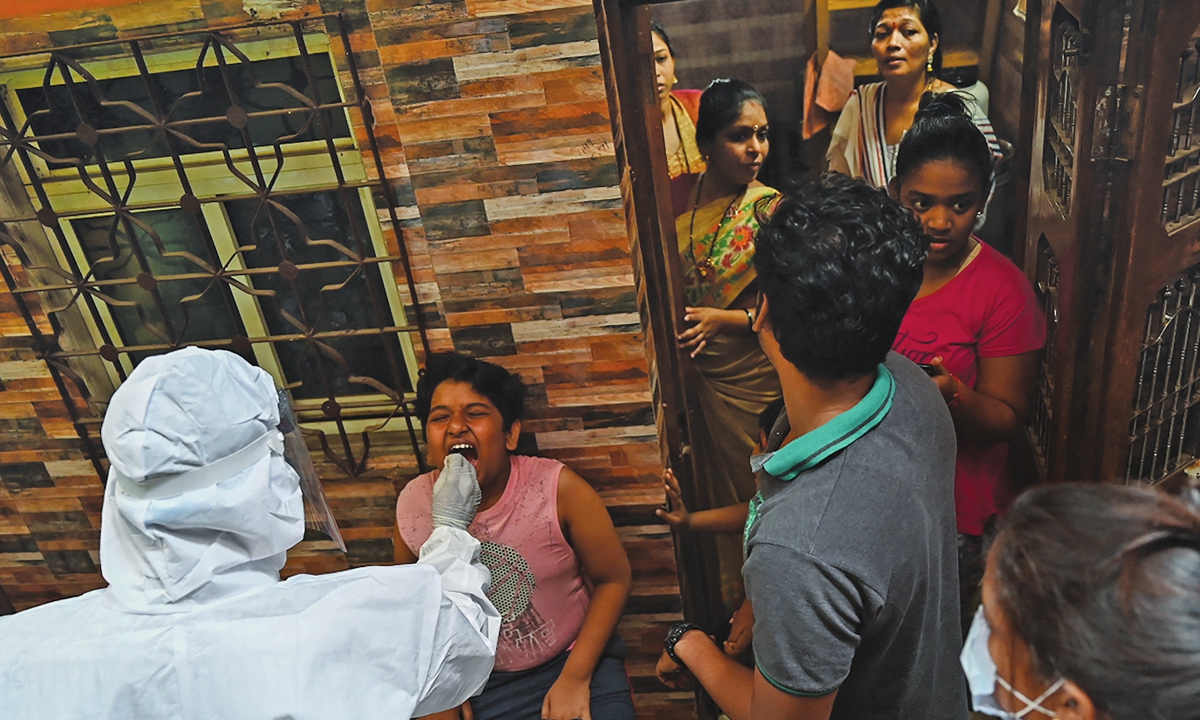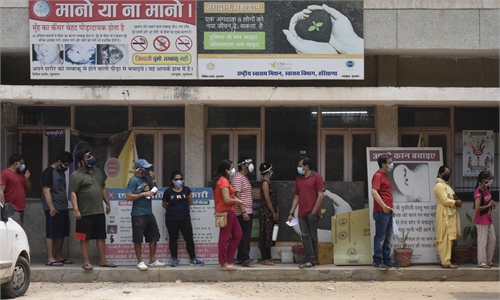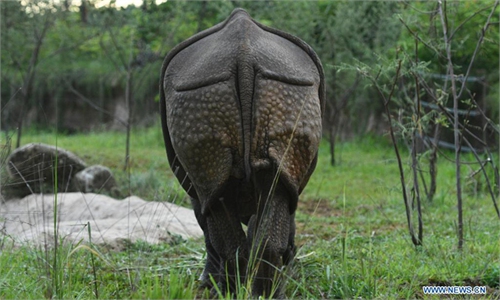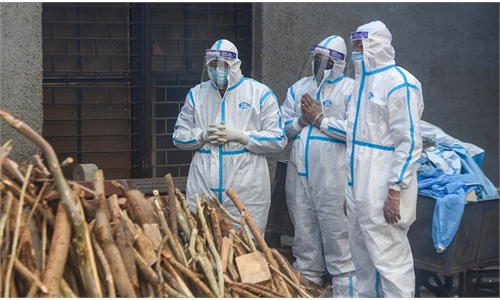Farhana Shaikh used to recoil in disgust when she would go to the communal toilet in Dharavi. But since the pandemic struck, efforts to fight COVID-19 have dramatically improved public sanitation in one of Asia's largest slums.

"The toilet is being cleaned every day since the last year as against once a week earlier. There's soap and sanitizer and a box for disposing [of] sanitary pads that were otherwise strewn around," Shaikh, 30, told Reuters.
"People are also more cautious now: they are using masks and sanitizers... exposure to deaths and infections has made everyone fearful," said the mother of one.
Home to 850,000 people cramped in 55,000 mostly one-room homes, Dharavi's confirmed coronavirus disease cases fell to nine on Monday - down from a one-day peak of 99 in April, according to local government data.
Residents and local officials say that is largely the result of lessons learned during 2020's first wave of cases when Dharavi defied expectations by tackling an initial surge in infections.
A testing protocol including free tests for tens of thousands of residents was revived as cases crept into double digits, fever camps were set up to scan for symptoms, and quarantine facilities set up in 2020 were reopened.
Despite vaccine shortages, announcements are blared out from loudspeakers across the slum, urging residents to get vaccinated. Another campaign sought to overcome vaccine hesitancy by offering free soap to anyone getting their jab.
"There is a strong community outreach, contact tracing continues, and toilets are being deep cleaned with jet sprays," said Yusuf Kabir, a water, sanitation, and health specialist with UNICEF, listing factors that helped the slum turn the tide.
Toilet operators and sanitation workers are more vigilant, Kabir said.
"No one can guarantee it won't be affected in the third wave. But Dharavi is not complacent," he said.
'We were going mad'
About a third of the world's urban population lives in informal settlements like Dharavi, which lies at the heart of India's economic hub, according to the United Nations.
Poor living conditions, malnutrition, and weakened immune systems make slum dwellers more vulnerable to contracting infections, disease experts have warned.
Wary of Dharavi's potential to become a COVID-19 nightmare, Mumbai's civic officials were closely monitoring cases in the neighborhood when India's deadly second wave took hold in March.
Initially, the slum's quarantine centers were empty. Some experts suggested the metropolis might have moved towards herd immunity following 2020's outbreak. "Everybody sensed if Dharavi was fine, Mumbai was fine. We slightly misjudged Dharavi's quiet and calm as everything under control," said Kiran Dighavkar, assistant municipal commissioner with Mumbai's civic body.
Cases in Mumbai and Dharavi steadily increased through March, peaking in April to a daily high of 11,000 cases, before steadily coming down to less than 2,000 on Monday.
"The 15 days from April 10 to 25 were horrible. We were going mad," Dighavkar said, adding that lessons learned in the slum had helped the city as a whole respond to the crisis. "We adopted the Dharavi model of aggressive testing and screening. And that actually helped," Dighavkar said.
Paying attention
Local politician and Dharavi resident Babu Khan spent years challenging Mumbai's municipal corporation over poor hygiene, overcrowding, and rubbish-dumping in the slum that heightened the risk of disease.
But the COVID-19 crisis has forced both authorities and local people to rethink sanitation and public health issues.
"The coronavirus [disease] has changed a lot: Doctors, health posts, [and] ward officers are paying attention. Dharavi has got the attention we had been seeking all these years," he said.
Residents are more cautious, too, and the slum's narrow streets are cleaner.
"After the first COVID-19 death in Dharavi last year, there was panic among people. They became alert and realized they had to save themselves," Khan said.
Local doctor Sudhir Patil who has been practicing in Dharavi for years said the number of asthmatic bronchitis and tuberculosis cases have dropped over 2020 as residents wear masks and take better care of their diets.
Despite a cautious optimism that the worst is over, officials are already making plans for a possible third wave, including setting up facilities for children, who are not yet eligible for vaccination.
"We can't assume everything is okay... every wave has its own challenges," said Dighavkar.
"But there is a positive impact of these changes in Dharavi on children who have had an early exposure to good habits. And that will be [a] permanent change."

A health worker wearing protective gear takes a swab sample of a resident for a coronavirus test at Dharavi slum in Mumbai, India, on March 11. Photo: AFP
As Indian cities face record daily deaths, new cases have plunged in the Mumbai slum in recent weeks as officials bolstered anti-virus measures first put in place in 2020 - from mass testing to disinfecting public areas, including bathrooms."The toilet is being cleaned every day since the last year as against once a week earlier. There's soap and sanitizer and a box for disposing [of] sanitary pads that were otherwise strewn around," Shaikh, 30, told Reuters.
"People are also more cautious now: they are using masks and sanitizers... exposure to deaths and infections has made everyone fearful," said the mother of one.
Home to 850,000 people cramped in 55,000 mostly one-room homes, Dharavi's confirmed coronavirus disease cases fell to nine on Monday - down from a one-day peak of 99 in April, according to local government data.
Residents and local officials say that is largely the result of lessons learned during 2020's first wave of cases when Dharavi defied expectations by tackling an initial surge in infections.
A testing protocol including free tests for tens of thousands of residents was revived as cases crept into double digits, fever camps were set up to scan for symptoms, and quarantine facilities set up in 2020 were reopened.
Despite vaccine shortages, announcements are blared out from loudspeakers across the slum, urging residents to get vaccinated. Another campaign sought to overcome vaccine hesitancy by offering free soap to anyone getting their jab.
"There is a strong community outreach, contact tracing continues, and toilets are being deep cleaned with jet sprays," said Yusuf Kabir, a water, sanitation, and health specialist with UNICEF, listing factors that helped the slum turn the tide.
Toilet operators and sanitation workers are more vigilant, Kabir said.
"No one can guarantee it won't be affected in the third wave. But Dharavi is not complacent," he said.
'We were going mad'
About a third of the world's urban population lives in informal settlements like Dharavi, which lies at the heart of India's economic hub, according to the United Nations.
Poor living conditions, malnutrition, and weakened immune systems make slum dwellers more vulnerable to contracting infections, disease experts have warned.
Wary of Dharavi's potential to become a COVID-19 nightmare, Mumbai's civic officials were closely monitoring cases in the neighborhood when India's deadly second wave took hold in March.
Initially, the slum's quarantine centers were empty. Some experts suggested the metropolis might have moved towards herd immunity following 2020's outbreak. "Everybody sensed if Dharavi was fine, Mumbai was fine. We slightly misjudged Dharavi's quiet and calm as everything under control," said Kiran Dighavkar, assistant municipal commissioner with Mumbai's civic body.
Cases in Mumbai and Dharavi steadily increased through March, peaking in April to a daily high of 11,000 cases, before steadily coming down to less than 2,000 on Monday.
"The 15 days from April 10 to 25 were horrible. We were going mad," Dighavkar said, adding that lessons learned in the slum had helped the city as a whole respond to the crisis. "We adopted the Dharavi model of aggressive testing and screening. And that actually helped," Dighavkar said.
Paying attention
Local politician and Dharavi resident Babu Khan spent years challenging Mumbai's municipal corporation over poor hygiene, overcrowding, and rubbish-dumping in the slum that heightened the risk of disease.
But the COVID-19 crisis has forced both authorities and local people to rethink sanitation and public health issues.
"The coronavirus [disease] has changed a lot: Doctors, health posts, [and] ward officers are paying attention. Dharavi has got the attention we had been seeking all these years," he said.
Residents are more cautious, too, and the slum's narrow streets are cleaner.
"After the first COVID-19 death in Dharavi last year, there was panic among people. They became alert and realized they had to save themselves," Khan said.
Local doctor Sudhir Patil who has been practicing in Dharavi for years said the number of asthmatic bronchitis and tuberculosis cases have dropped over 2020 as residents wear masks and take better care of their diets.
Despite a cautious optimism that the worst is over, officials are already making plans for a possible third wave, including setting up facilities for children, who are not yet eligible for vaccination.
"We can't assume everything is okay... every wave has its own challenges," said Dighavkar.
"But there is a positive impact of these changes in Dharavi on children who have had an early exposure to good habits. And that will be [a] permanent change."



